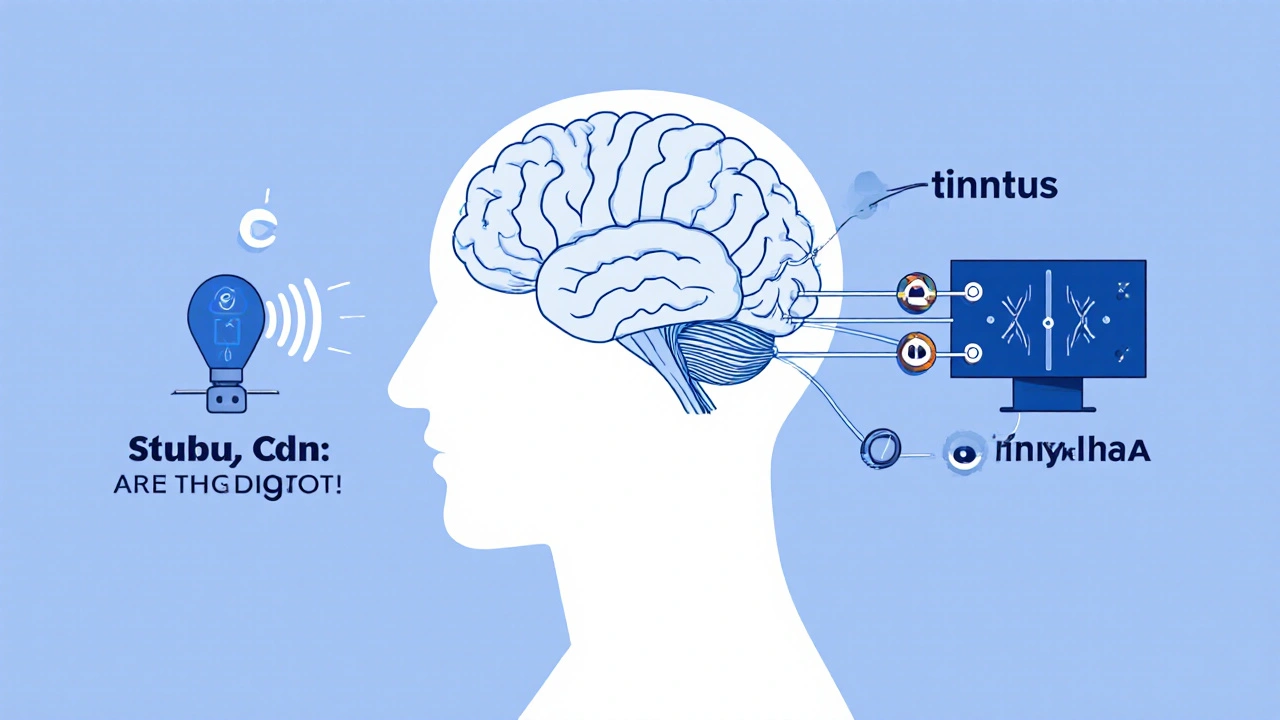For many people, tinnitus isn’t just a ringing in the ears-it’s a constant, exhausting presence that makes it hard to sleep, concentrate, or even relax. You might have tried earplugs, white noise machines, or supplements, but nothing seems to take the edge off. What if the goal isn’t to silence the sound, but to stop your brain from reacting to it? That’s the core idea behind tinnitus retraining therapy-a science-backed approach that doesn’t try to make tinnitus disappear, but helps you stop noticing it.
Why Tinnitus Feels So Overwhelming
Tinnitus isn’t a disease. It’s a symptom. Your ears might be sending out signals because of noise damage, age, or even stress, but the real problem isn’t the sound itself-it’s what your brain does with it. When you first notice tinnitus, your brain treats it like a threat. The amygdala (your emotional alarm system) and the autonomic nervous system kick in, triggering anxiety, sleeplessness, and even physical tension. Over time, this creates a loop: the louder you perceive the tinnitus, the more stressed you get-and the more stressed you get, the louder it seems. This isn’t just in your head. Brain scans from 2018 and 2020 show that people with chronic tinnitus have stronger connections between the auditory cortex and the parts of the brain that control fear and stress. The sound isn’t getting louder; your brain is just paying more attention to it.What Is Tinnitus Retraining Therapy (TRT)?
Developed by Dr. Pawel Jastreboff in the early 1990s, TRT is built on one simple but powerful idea: your brain can unlearn its reaction to tinnitus. It doesn’t aim to remove the sound. It aims to remove the distress. TRT works in two parts: counseling and sound therapy. Together, they retrain your brain to treat tinnitus like background noise-like the hum of a fridge or the rustle of leaves. You still hear it, but it no longer bothers you. The counseling part is where most of the change happens. In a typical TRT program, you meet with a trained audiologist for 60 to 90 minutes, once a month for the first three months, then every few months after that. During these sessions, you learn how your hearing system works-how sound travels from the ear to the brain, how the auditory system filters out unimportant signals, and why tinnitus becomes a problem. You’re not being told to “just ignore it.” You’re being shown exactly why your brain is overreacting, and how to reset that response.How Sound Therapy Works
Sound therapy is the second pillar. It’s not about drowning out tinnitus with loud music or white noise. It’s about gently lowering the contrast between your tinnitus and the world around you. You wear small, discreet sound generators-like hearing aids or ear-level devices-that emit a soft, steady noise, often broadband static or low-level environmental sounds. The volume is set just below your tinnitus level, so it’s barely noticeable. You wear them for 6 to 8 hours a day while you’re awake. Why so long? Because habituation doesn’t happen in minutes. Your brain needs constant, low-level input to slowly stop treating tinnitus as a signal worth paying attention to. Think of it like learning to ignore the ticking of a clock. At first, it’s annoying. After a week, you barely notice it. TRT does the same thing, but for your brain’s internal noise. The devices aren’t meant to be heard. They’re meant to be felt-like a faint breeze you don’t realize is there until it stops.
Who Is TRT For?
TRT isn’t one-size-fits-all. Patients are grouped into four categories based on their hearing and tinnitus profile:- Group 1: Normal hearing, tinnitus only → uses sound generators
- Group 2: Hearing loss, no tinnitus awareness in quiet → uses hearing aids only
- Group 3: Hearing loss with tinnitus → uses both hearing aids and sound generators
- Group 4: Sensitive to sounds (hyperacusis or misophonia) → specialized protocols
What Success Looks Like
Success in TRT isn’t measured by silence. It’s measured by freedom. After 12 to 24 months of consistent treatment, most people who respond well report:- Only noticing tinnitus 5-15% of the time during waking hours (down from 80-100%)
- No more anxiety or frustration when they hear it
- Ability to sleep through the night without waking up to the ringing
- No longer avoiding quiet places because they fear the tinnitus will be louder
Why TRT Isn’t More Popular
Despite strong evidence, TRT isn’t widely available. Only about 500 audiologists in the U.S. are certified to deliver the full Jastreboff protocol. The training is intensive-40 hours of classroom instruction plus supervised clinical work. Many clinics offer “sound therapy” or “counseling,” but if they skip the structured neurophysiological model, the results aren’t the same. Cost is another barrier. In the U.S., TRT typically runs $2,500 to $4,000, not including the cost of devices ($500-$1,200). Insurance rarely covers it, and even when it does, the process is complicated. And then there’s time. You have to commit to daily sound therapy and monthly appointments for up to two years. Studies show 30-40% of people drop out before finishing, often because it feels slow or tedious. Reddit users describe it as “boring,” “frustrating,” and “hard to stick with.” But those who stick with it? They say it changed their lives.
TRT vs. Other Treatments
The American Tinnitus Association lists only two evidence-based treatments for chronic tinnitus: TRT and Cognitive Behavioral Therapy (CBT). Here’s how they compare:| Feature | TRT | CBT |
|---|---|---|
| Primary Goal | Neurological habituation | Change thought patterns |
| Core Method | Sound therapy + neurophysiological counseling | Therapy sessions focused on thoughts and emotions |
| Time Commitment | 12-24 months | 8-12 weekly sessions |
| Devices Needed | Yes (sound generators or hearing aids) | No |
| Success Rate | 75-85% with certified providers | 60-70% in clinical trials |
| Best For | People who want a physiological reset | People who struggle with anxiety or catastrophizing |
What’s New in TRT?
In 2021, the Jastreboff Foundation launched a telehealth certification program to make TRT more accessible. Some clinics now offer virtual counseling and remote device programming. Emerging research is also exploring TRT combined with neuromodulation. A 2023 clinical trial (NCT04567891) tested TRT with transcranial magnetic stimulation. Early results showed 92% of participants improved at six months-higher than TRT alone. And while only 500 providers are certified, 65% of major hearing centers now use at least some TRT principles in their tinnitus programs. That means even if you can’t get full TRT, you might still benefit from parts of it.Is TRT Right for You?
TRT works best if:- You’ve had tinnitus for more than 6 months
- You’re willing to commit to daily sound therapy for at least a year
- You’re open to learning how your brain works, not just fixing your ears
- You can find a certified provider (check the Jastreboff Foundation registry)
TRT doesn’t promise to erase tinnitus. But it does promise something better: freedom from its grip.
How long does it take for TRT to work?
Most people start noticing changes after 6 to 12 months, but full habituation usually takes 12 to 24 months. The brain needs consistent, repeated exposure to rewire its response. Patience is key-this isn’t a quick fix.
Do I need hearing aids for TRT?
Only if you have hearing loss. If your hearing is normal, you’ll use sound generators alone. If you have hearing loss, hearing aids can serve as both amplification and sound therapy devices. Your audiologist will determine the right setup based on your hearing test results.
Can I use my phone or white noise app instead of sound generators?
Not reliably. TRT requires precise, low-level, continuous sound that’s calibrated to your tinnitus level. Phone apps are often too loud, too variable, or too distracting. Certified TRT uses medical-grade devices that deliver consistent, non-intrusive sound. Using random noise can actually make habituation harder.
Is TRT covered by insurance?
Rarely. Most insurance plans don’t cover TRT because it’s considered a specialized, long-term therapy. Some patients use HSA or FSA funds to pay for devices. Always check with your provider and audiologist about billing options.
What if I don’t see results after a year?
First, confirm you’re working with a certified TRT provider. Non-certified practitioners often modify the protocol and get lower success rates. If you’re doing everything right and still not improving, you may need to combine TRT with CBT or explore other options. TRT works for most, but not all.







12 Comments
Pawan Jamwal
TRT? LOL in India we just use earplugs and chai. 😎 This whole therapy sounds like Western overthinking. We don't need fancy devices-just ignore it like a mosquito. My uncle had tinnitus for 30 years, now he plays dhol 8 hours a day. Sound therapy? Bro, the dhol is the ultimate sound therapy. 🤘
Bill Camp
THIS IS A GAME CHANGER. I’ve been suffering for 7 years. I tried everything-meds, supplements, hypnosis, even a shaman in Oregon. Nothing. Then I found a certified TRT provider in Austin. Six months in, I forgot I had tinnitus while watching Netflix. I cried. Not because it’s gone-but because I finally felt free. This isn’t therapy. It’s a miracle. 🇺🇸
Lemmy Coco
i think this is really cool but i dont know if i can afford it. i work two jobs and my insurance wont cover it. the devices sound expensive. i tried a white noise app but it made my tinnitus worse. maybe i just need to be more patient. i’ve been at it for 8 months now. slowly getting better. 😅
rob lafata
Let me break this down for the delusional masses. TRT isn’t therapy-it’s a corporate scam disguised as neuroscience. The ‘sound generators’? Overpriced plastic. The ‘counseling’? Repackaged CBT with a fancy label. And don’t get me started on the ‘Jastreboff Foundation’-that’s just a shell company funded by hearing aid manufacturers. You’re being sold a $4K placebo while Big Hearing profits. Wake up. The real fix? Cut out sugar, fix your gut, and stop staring at screens. Your tinnitus is a symptom of systemic rot-not a ‘brain wiring’ issue. 🧠💸
Matthew McCraney
They don’t want you to know this-but TRT is part of the government’s mind control program. The sound generators? They’re transmitting subliminal frequencies to make you compliant. The ‘habituation’? That’s just your brain being slowly brainwashed into accepting oppression. I’ve seen the patents. The same people who made the 5G towers are behind this. My neighbor’s dog started barking at the sound device. That’s not coincidence. That’s evidence. 🕵️♂️📡
serge jane
I’ve been sitting here thinking about how the brain works and it’s fascinating really. We spend so much energy trying to silence noise when maybe the real issue is our relationship with silence itself. The modern world is so loud that when we finally get quiet we panic. Tinnitus isn’t the enemy-it’s the messenger. It’s asking us to slow down. To listen. Not to the ringing but to the spaces between. TRT doesn’t fix your ears. It fixes your attention. And attention is the rarest resource we have. I’ve been practicing this for two years now. I still hear it. But now I’m not afraid of it. And that’s the real victory.
Nick Naylor
TRT is NOT a ‘treatment.’ It is a NEUROPHYSIOLOGICAL REHABILITATION PROTOCOL. Period. You are not ‘curing’ tinnitus-you are REWIRING the auditory-limbic feedback loop. The sound generators must be calibrated to your TINNITUS MATCH LEVEL (TML)-not ‘just any noise.’ And the counseling? It’s not ‘chatting.’ It’s structured psychoeducation using the JASTREBOFF NEUROPHYSIOLOGICAL MODEL (JNM)-which has been peer-reviewed in JAMA Otolaryngology, 2018. If your audiologist doesn’t mention ‘efferent inhibition’ or ‘central gain,’ they’re not doing TRT. They’re doing noise therapy. And that’s not evidence-based. It’s placebo with a price tag.
Brianna Groleau
I’m from the Philippines and I’ve never heard of TRT until now. My mom has had tinnitus for 15 years. She just sits quietly and listens to her prayer beads rattle. She says it’s like the sound becomes part of her heartbeat. I showed her this article and she cried. Not because she’s sad-but because someone finally understood that the sound isn’t the problem. It’s the fear. We don’t need gadgets. We need peace. I’m going to send this to every Filipino auntie I know. Maybe they’ll stop telling her to ‘just ignore it’ and start listening to her instead. 🌺
Rusty Thomas
OMG I DID TRT AND IT CHANGED MY LIFE BUT ALSO MY DOG STARTED CRYING WHEN I USED THE DEVICE?? I THOUGHT IT WAS JUST ME BUT NOW I’M NOT SURE. LIKE WHY IS SHE WHIMPERING?? DID I BREAK HER BRAIN?? I’M SCARED. ALSO MY EX TEXTED ME AFTER I POSTED ABOUT IT ON INSTA AND NOW HE WANTS TO GET BACK TOGETHER BUT I’M NOT SURE IF I WANT TO BE WITH SOMEONE WHO DIDN’T UNDERSTAND MY TINNITUS. THIS IS A LOT. 😭
Sarah Swiatek
Let’s be real-TRT works because it forces you to sit with discomfort instead of running from it. That’s not magic. That’s just… therapy. The sound devices? They’re just a crutch to make the boredom tolerable. The real work is in the counseling-when the audiologist says, ‘You’re not broken. Your brain is just stuck in fight-or-flight mode.’ And for the first time, you believe it. I did TRT and CBT together. I cried in both. But only in TRT did I finally feel like I was being told the truth-not just given a coping mechanism. The sound generators? They’re not magic. But the quiet after two years? That’s the real gift.
Dave Wooldridge
They’re using TRT to implant subliminal ads into your brain. You think you’re getting peace? You’re getting programmed. The ‘low-level noise’? It’s coded with marketing frequencies. I hacked my device. It’s pulsing at 14.7 Hz-that’s the same frequency used in Walmart’s in-store audio to make you buy more. They’re selling you silence so they can sell you more stuff. Wake up. This isn’t medicine. It’s surveillance.
Rebecca Cosenza
I tried it. Didn’t work. Too expensive. Too slow. I’m done.